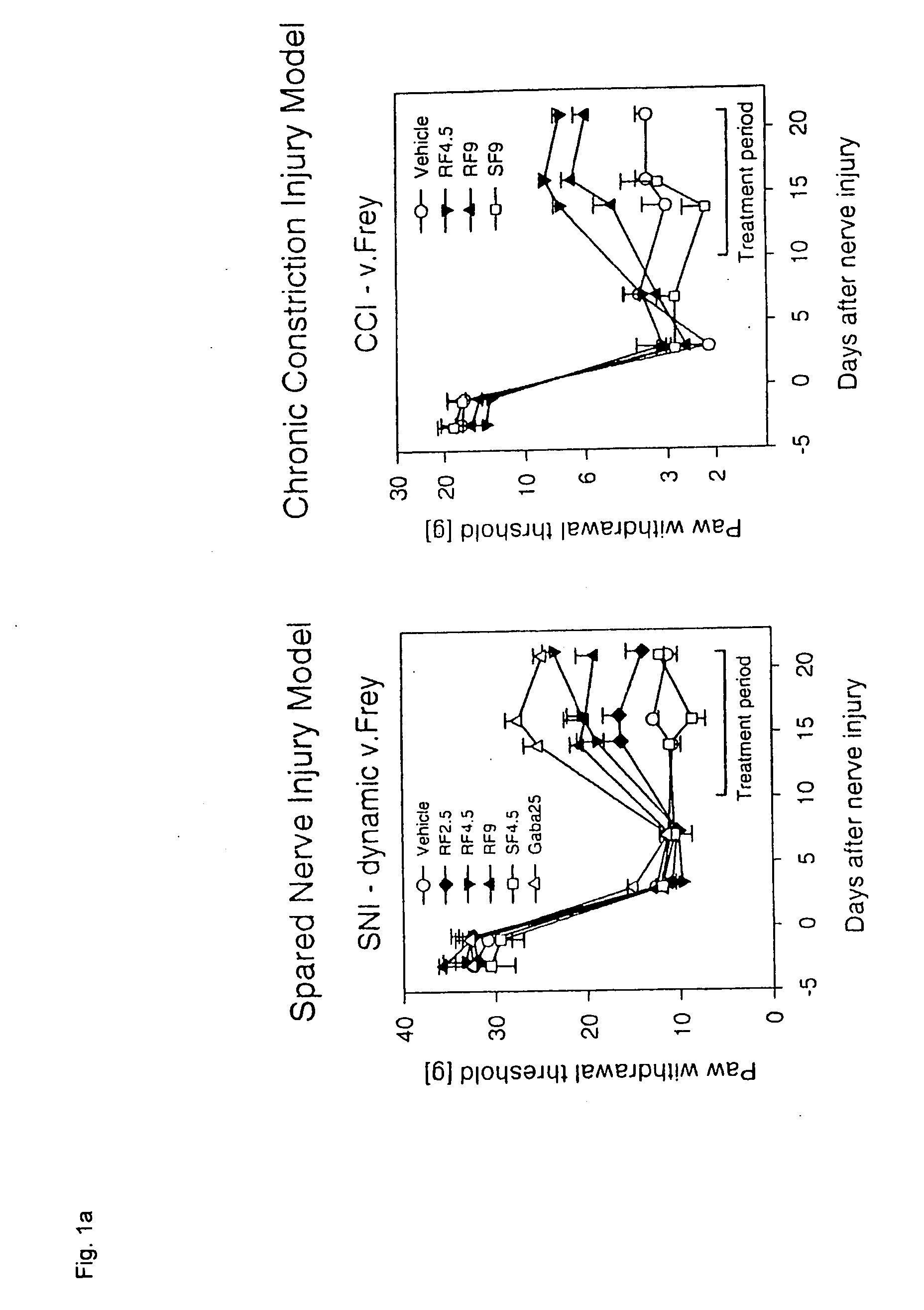Drugs as well as their production and use in the treatment of pain-associated neuropathies
a neuropathic and pain technology, applied in the field of pain-associated neuropathies, can solve the problems of significant impairment of the quality of life of patients by neuropathies, side effects, and limited clinical applicability of spinal applications selected in animal models, and achieve the effect of reducing the evoked neuropathic pain
- Summary
- Abstract
- Description
- Claims
- Application Information
AI Technical Summary
Benefits of technology
Problems solved by technology
Method used
Image
Examples
example 1
[0063]The Chronic Constriction Injury model (CCI model) [Bennet G J, Xie Y K: A peripheral mononeuropathy in rat that produces disorders of pain sensation like those seen in man. Pain 1988, 33:87-107] and the Spared Nerve Injury model (SNI model) [Decosterd I, Woolf C J: Spared Nerve injury: an animal model of persistent peripheral neuropathic pain. Pain 2000, 87:149-158] were used as animal models that show essential elements of the clinical pain syndromes in the presence of neuropathies. In both models, the animals sustain defined nerve damage by surgical means. The pain behavior of the animals can be used to quantitatively measure the efficacy of substances in pain-associated neuropathies. The investigations were carried out on rats according to the published models. In rats, it is possible to measure the effect of tarenflurbil exclusively, since they, like man, basically do not invert tarenflurbil to S-flurbiprofen. The same is not true of most other species of laboratory animal...
example 2
[0066]In another series of experiments, animals having sustained nerve damage according to the SNI model were treated twice daily with intraperitoneal doses of 9 mg / kg body weight tarenflurbil or vehicle from the first postoperative day and for a period of two weeks. Both the mechanical dynamic allodynia (on the ipsilateral and on the contralateral side) and the cold allodynia (ipsilateral only) were measured by means of Frey's aesthesiometer and the cold plate at 10° C., respectively.
[0067]The results of this series of experiments are summarized in FIG. 2. Tarenflurbil (RF9-ipsi) shows a significantly different effect from vehicle (vehicle-ipsi) on the ipsilateral side with regard to mechanical allodynia and cold allodynia during the entire treatment period of two weeks. On the contralateral side, there is no difference between tarenflurbil (RF9-contra) and vehicle (vehicle-contra). After completion of treatment, the pain-relieving effect decreases slowly in the group treated with ...
example 3
[0068]For qualification of the series' of experiments mentioned above, a single dose of 9 mg / kg body weight tarenflurbil (RF9) or vehicle (vehicle) was applied intraperitoneally in another series of experiments on rats that had not sustained damage and the mechanical allodynia and the heat sensitivity were measured for up to 6 hours after the application using Frey's aesthesiometer and the Hargreaves model, respectively. The results shown in FIG. 3 evidence no significant differences between the groups treated with tarenflurbil versus vehicle. This means that the effects measured for tarenflurbil in Examples 1 and 2 are exclusively related to the effect in pain-associated neuropathies.
PUM
| Property | Measurement | Unit |
|---|---|---|
| Mass | aaaaa | aaaaa |
| Mass | aaaaa | aaaaa |
| Mass | aaaaa | aaaaa |
Abstract
Description
Claims
Application Information
 Login to View More
Login to View More - R&D
- Intellectual Property
- Life Sciences
- Materials
- Tech Scout
- Unparalleled Data Quality
- Higher Quality Content
- 60% Fewer Hallucinations
Browse by: Latest US Patents, China's latest patents, Technical Efficacy Thesaurus, Application Domain, Technology Topic, Popular Technical Reports.
© 2025 PatSnap. All rights reserved.Legal|Privacy policy|Modern Slavery Act Transparency Statement|Sitemap|About US| Contact US: help@patsnap.com



